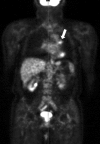Atypical presentation of typical carcinoid
- PMID: 24443340
- PMCID: PMC3903162
- DOI: 10.1136/bcr-2013-202870
Atypical presentation of typical carcinoid
Abstract
Bronchial carcinoid tumours can present with symptoms of distal airway obstruction, local airway irritation or bleeding due to hypervascularity. Presentation with a spontaneous pneumothorax (SP) is rare. We present a case of typical endobronchial carcinoid tumour that presented with a SP. We explored the possible mechanisms of this rare presentation, especially the check-valve mechanism of airway obstruction, which was evident during the fiberoptic bronchoscopic examination.
Figures






Similar articles
-
Pneumothorax as atypical presentation of bronchial carcinoid.Ann Thorac Surg. 2013 Dec;96(6):2219-21. doi: 10.1016/j.athoracsur.2013.03.111. Ann Thorac Surg. 2013. PMID: 24296189
-
[Spontaneous pneumomediastinum: a rare picture of endobronchial neoplasm presentation. A case report].Radiol Med. 1997 Sep;94(3):262-4. Radiol Med. 1997. PMID: 9446136 Review. Italian. No abstract available.
-
[Bronchial carcinoid tumor and recurrent pneumothoraxes].Rev Pneumol Clin. 2017 Oct;73(5):263-266. doi: 10.1016/j.pneumo.2017.08.007. Epub 2017 Oct 12. Rev Pneumol Clin. 2017. PMID: 29031965 French.
-
Spontaneous left pneumothorax revealing an atypical carcinoid tumor: a case report.Pan Afr Med J. 2024 Nov 26;49:93. doi: 10.11604/pamj.2024.49.93.45209. eCollection 2024. Pan Afr Med J. 2024. PMID: 40060277 Free PMC article.
-
[Bronchial carcinoid tumors in children].Bull Cancer. 2011 Jun;98(6):709-15. doi: 10.1684/bdc.2011.1369. Bull Cancer. 2011. PMID: 21622089 Review. French.
Cited by
-
Pulmonary carcinoid presenting with persistent pneumothorax.BMJ Case Rep. 2019 Nov 10;12(11):e231083. doi: 10.1136/bcr-2019-231083. BMJ Case Rep. 2019. PMID: 31712234 Free PMC article.
-
Pulmonary carcinoid presenting in pregnancy with an unusual radiological feature.BMJ Case Rep. 2021 Apr 15;14(4):e241231. doi: 10.1136/bcr-2020-241231. BMJ Case Rep. 2021. PMID: 33858898 Free PMC article.
-
Spontaneous massive hemothorax as an atypical presentation of bronchial carcinoid.Turk Gogus Kalp Damar Cerrahisi Derg. 2022 Apr 27;30(2):289-293. doi: 10.5606/tgkdc.dergisi.2022.20581. eCollection 2022 Apr. Turk Gogus Kalp Damar Cerrahisi Derg. 2022. PMID: 36168566 Free PMC article.
-
Pneumothorax as a rare presentation of bronchial schwannoma.Respir Med Case Rep. 2022 Jan 30;36:101590. doi: 10.1016/j.rmcr.2022.101590. eCollection 2022. Respir Med Case Rep. 2022. PMID: 35198367 Free PMC article.
References
-
- Jackson C, Jackson CL. Bronchoesophagology. Philadelphia: W.B. Saunders Company, 1950:17, 195–9
-
- Wagner RB, Knox GS. Pneumothorax: an unusual manifestation of a bronchial carcinoid. Md Med J 1990;39:263–5 - PubMed
-
- Park CM, Goo JM, Lee HJ, et al. Tumors in the tracheobronchial tree: CT and FDG PET features. Radiographics 2009;29:55–71 - PubMed
-
- Rekhtman N. Neuroendocrine tumors of the lung: an update. Arch Pathol Lab Med 2010;134:1628–38 - PubMed
-
- Morandi U, Casali C, Rossi G. Bronchial typical carcinoid tumors. Semin Thorac Cardiovasc Surg 2006;18:191–8 - PubMed
Publication types
MeSH terms
LinkOut - more resources
Full Text Sources
Other Literature Sources
Medical
